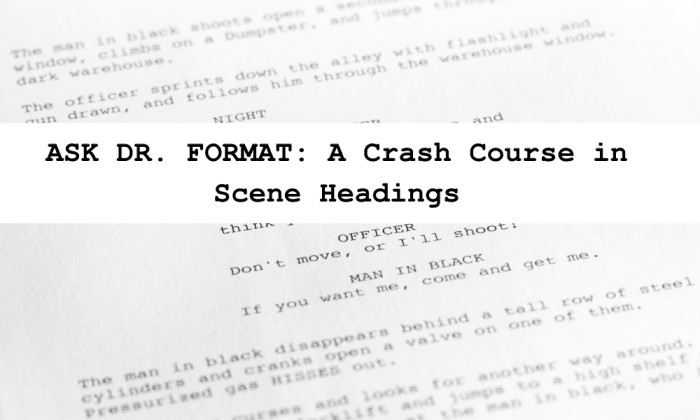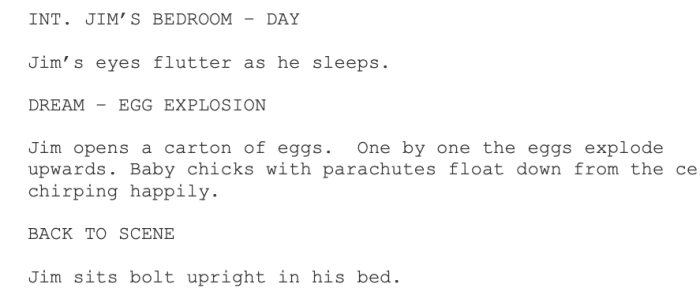Using Same and Continuous in Script
Click to tweet this article to your friends and followers!

QUESTION
I am confused. I hear conflicting advice about how and when to use slugs. Could you explain in terms that even a child can understand?
ANSWER
As a script consultant, I see more errors with scene headings than with any other formatting tool, so let's review the use of this important tool and avoid future embarrassment with readers.
The nicknames slug, slugs, and slug lines derive from journalism, but they're perfectly okay to use. Most everyone uses these terms, but sometimes knowing the given name for something can help us understand it a little better. Scene headings, the given name, are headings for scenes. Open your copy of Final Draft or Screenwriter and you'll see an "element" for scene heading.
The Basics
A scene heading consists of three parts: camera position (EXTERIOR or INTERIOR), the location, and the time (DAY, NIGHT, LATER, CONTINUOUS, SAME).

Be consistent in your location names. For example, once you call this JIM'S HOUSE, then refer to it in scene headings as JIM'S HOUSE thereafter.
If any one of the three sections (or parts) of a scene heading changes (camera position, location, or time), then you have a new scene requiring a new scene heading.
Do not include description in a scene heading, such as WIND RUSTLING THROUGH TREES. Description belongs in the description (action) section. The location for the above is probably WOODS or JIM'S BACK YARD or wherever those trees are. Is the following a correct scene heading?

No, it is not correct because CHRISTMAS DAY is not a location.
On occasion, you see a fourth part to a scene heading; that's for any additional relevant information. For example:

That informs the reader of the year, but not the audience. If you want the audience to know the year, then use a Superimpose command (SUPER). Some writers will add FLASHBACK or DREAM as a fourth part of a scene heading.
[Script Extra: All About Flashbacks]
What if you want the reader to know that the house is in Los Angeles? Los Angeles is not an INTERIOR location, so you handle this parenthetically:

Once you've established that overall geographical location, you do not need to do it again.
As an alternative to the above strategy, establish Los Angeles in an EXTERIOR scene first, followed by the HOUSE scene.
Car Scenes
What if you want the camera to alternate between the car interior and outside of the car? Rather than bouncing back and forth between scene headings, use the slash as follows:

The above means the camera can be inside or outside the car at the whim of the director or editor.
There are three kinds of scenes: master (or primary) scenes, secondary scenes, and special scenes. Let's review the formatting of all three.
Master Scene Headings and Secondary Scene Headings
The following is a master scene heading:

It contains all three parts of a scene heading. The HOUSE is the master or primary location. The HOUSE may contain secondary locations such as the KITCHEN and BEDROOM. These are secondary because they are part of the primary location, the HOUSE. In a spec script, you may use secondary scene headings if you wish. For example:

In the above example, KITCHEN is a secondary scene heading; it is part of the INTERIOR of the house. LATER is a change in the time (the third part of a scene heading), and it's perfectly okay to use it as a secondary scene heading.
This strategy becomes handy for long scenes such as a car chase through the STREETS OF SAN FRANCISCO (the master or primary location) where secondary locations can be identified: LOMBARD STREET, AN INTERSECTION, STREET BIZARRE, and so on.
[Script Extra: Shooting Scripts vs. Spec Scripts]
Keep in mind that you seldom see secondary scene headings in shooting scripts, and there are a rare few professionals that prefer you don't in a spec script. Most readers don't care as long as you are clear and consistent. However, if you decide not use secondary scene headings, then the following is acceptable:

Actually, that second scene heading should end with CONTINUOUS, since the KITCHEN scene is CONTINUOUS. However, since it is already obvious that the scene is CONTINUOUS and that it is also DAY, you don't need to place anything in the "time" section, although you can if you wish.
There is still another method for spec writers. Since the KITCHEN is part of the house and the scenes are short, you could write as follows:

Continuous and Same
CONTINUOUS means the scene follows the previous scene continuously without any jump in time. SAME means the scene happens at the same time as the previous scene.
Special Scene Headings
There are two main ways to format a special scene such as a DREAM, FLASHBACK, VISION, DAYDREAM, MIRAGE, INSERT, and so on.
1. If the dream or flashback (or other special situation) is only one scene long and it interrupts a scene, handle it as follows:

The term BACK TO SCENE could be replaced by BACK TO BEDROOM if you prefer.
Use this method for the MONTAGE and SERIES OF SHOTS.
2. If the special situation consists of more than one scene, then handle it in this manner:

There are a variety of other methods for special headings, but the above two are the most common by far. If you still have a question about scene headings, email it to me at dave@keepwriting.com and keep writing!
Read Part 2 of a Crash Course in Scene Headings!
The new, 7th edition of The Screenwriter's Bible is available at bookstores, Amazon, and www.keepwriting.com
More articles by Dave Trottier
If your ending is lackluster, you need Dave's Screenwriters University's online course, Powerful Endings to Hook Your Readers!
REGISTER NOW!

robinsondifes2000.blogspot.com
Source: https://scriptmag.com/screenplays/ask-dr-format-a-crash-course-in-scene-headings
0 Response to "Using Same and Continuous in Script"
Post a Comment